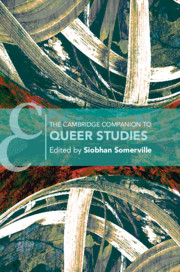Book contents
- The Cambridge Companion to Queer Studies
- The Cambridge Companion to Queer Studies
- Copyright page
- Dedication
- Contents
- Figures
- Contributors
- Acknowledgments
- Chronology
- Introduction
- Part I Genealogies
- Part II Confluences
- Chapter 3 Convergence, Dissymmetry, Duplicities
- Chapter 4 Transgender Studies, or How to Do Things with Trans*
- Chapter 5 Queer Indigenous Studies, or Thirza Cuthand’s Indigequeer Film
- Chapter 6 Queer Disability Studies
- Chapter 7 Queer Ecologies and Queer Environmentalisms
- Part III Representation
- Part IV Key Words
- Index
- Cambridge Companions to …
- References
Chapter 6 - Queer Disability Studies
from Part II - Confluences
Published online by Cambridge University Press: 02 June 2020
- The Cambridge Companion to Queer Studies
- The Cambridge Companion to Queer Studies
- Copyright page
- Dedication
- Contents
- Figures
- Contributors
- Acknowledgments
- Chronology
- Introduction
- Part I Genealogies
- Part II Confluences
- Chapter 3 Convergence, Dissymmetry, Duplicities
- Chapter 4 Transgender Studies, or How to Do Things with Trans*
- Chapter 5 Queer Indigenous Studies, or Thirza Cuthand’s Indigequeer Film
- Chapter 6 Queer Disability Studies
- Chapter 7 Queer Ecologies and Queer Environmentalisms
- Part III Representation
- Part IV Key Words
- Index
- Cambridge Companions to …
- References
Summary
This chapter uses Leah Lakshmi Piepzna-Samarasinha’s 2009 performance piece “The River” to provide an overview of queer disability studies in the United States. As with many cultural workers writing about disability from queer perspectives, Piepzna-Samarasinha complicates concepts of pride and identity; explores the effects of diagnostic categories; and yearns for queer crip futures. Sexuality plays a significant role in her piece, but Piepzna-Samarasinha avoids a straightforward narrative of liberation; pain, precarity, and debility co-exist here with pleasure. In order to situate Piepzna-Samarasinha’s work within a larger context of disability justice and queer disability studies, the chapter supplements her narratives with those of other contemporary theorists, artists, and activists. With an emphasis on the questions that queer disability studies poses for the study of literature and other cultural forms, the chapter attends to both the resonances and the friction between queer studies and disability studies.
Keywords
- Type
- Chapter
- Information
- The Cambridge Companion to Queer Studies , pp. 93 - 107Publisher: Cambridge University PressPrint publication year: 2020
References
Further Reading
- 2
- Cited by

